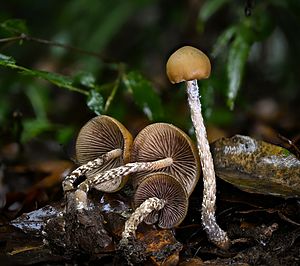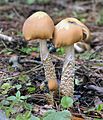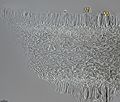Psilocybe zapotecorum facts for kids
Quick facts for kids Psilocybe zapotecorum |
|
|---|---|
 |
|
| Scientific classification | |
| Genus: |
Psilocybe
|
| Species: |
zapotecorum
|
| Synonyms | |
|
Psilocybe candidipes Singer & A.H. Sm. (1958) |
|
| Psilocybe zapotecorum | |
|---|---|
| Mycological characteristics | |
| gills on hymenium | |
| cap is conical or convex | |
| hymenium is adnate or sinuate | |
| stipe is bare | |
| spore print is purple-brown | |
| ecology is saprotrophic | |
Psilocybe zapotecorum is a type of mushroom. It belongs to a group of mushrooms called Psilocybe. This mushroom is found in many parts of Central and South America.
Contents
About the Name and History
This mushroom is named after the Zapotec peoples, an ancient group of people from Oaxaca Mexico. They live in the Sierra Madre de Oaxaca mountains.
The Zapotec people had a special name for this mushroom. Some say it means "Crown of thorns mushroom."
Key Discoveries and Studies
Scientists have studied Psilocybe zapotecorum for many years. Here are some important dates:
- 1956: The first main sample was collected on August 4, 1956. It was found in Santiago Yaitepec by Roger Heim and R. Gordon Wasson.
- 1957: Roger Heim and R. Gordon Wasson wrote about these mushrooms. They shared their findings in "Magic Mushrooms" in LIFE Magazine.
- 1958-9: Roger Heim published the first scientific description of this fungus.
- 1963: Roger Heim described this mushroom in his book "Les Champignons Toxiques et Hallucinogènes."
- 1976: Jonathan Ott and Gaston Guzman wrote more about the fungus. They called it Psilocybe candidipes at that time.
What Psilocybe zapotecorum Looks Like
Psilocybe zapotecorum has a unique look and smell. It smells and tastes a bit like flour or radishes.
The Cap
The cap of this mushroom can be 2 to 13 centimeters (about 1 to 5 inches) wide. It starts out shaped like a cone or a dome. Sometimes, it flattens out as the mushroom gets older.
The edge of the cap can be wavy. It often has a small point or a dip in the center. When the mushroom is young, the cap's edge looks scalloped. As it grows, the edge might curl upwards.
The cap's color changes over time. It can be yellowish-brown or tan. Then it fades to cream-yellow, brown, and finally black as it ages. The inside of the cap is white at first. But it quickly turns blue, then black, when it's damaged.
The Gills
The gills are the thin plates under the cap. When Psilocybe zapotecorum is young, its gills are a cream color. As it gets older, they turn violet-brown. The gills are attached to the stem in a way that is either wavy or directly joined. Sometimes they extend slightly down the stem.
The Spores
The spores are like tiny seeds that help the mushroom reproduce. They are dark violet-brown in color. Their shape can be oblong, oval, or somewhat diamond-shaped. They have thin walls and a small tip. The spores are very tiny, measuring about 6 to 7 micrometers long.
The Stipe (Stem)
The stem of Psilocybe zapotecorum can be quite long, from 3 to 26 centimeters (about 1 to 10 inches). It is usually 0.5 to 1 centimeter thick. The stem grows straight up and is often hollow inside. It can be white or gray.
As the mushroom ages, the stem turns yellowish, then blue, and finally black. The entire stem is covered with small white scales. These scales are easier to see near the bottom of the stem.
There is a thin, white, web-like cover called a partial veil when the mushroom is young. This veil usually disappears as the mushroom grows. Often, a long root-like structure, called a pseudorrhiza, is attached to the base of the stem. If the stem is damaged, it will strongly bruise blue, then turn black.
Where Psilocybe zapotecorum Lives
Psilocybe zapotecorum grows alone or in groups. Sometimes, many mushrooms can grow together in a cluster, even up to 50 at once!
Preferred Growing Places
You can often find this mushroom near rivers, creeks, and ravines. It sometimes grows right out of steep, mossy walls in these areas. It likes humid and shady spots. It grows in forests that are moist and green, like mesophytic forests. It also grows in oak and pine forests, or cloud forests.
This mushroom is often found in subtropical forests. These forests might have trees like Alnus (alder), Magnolia, Fraxinus (ash), and Quercus (oak). Large pine trees and blackberry bushes are also common in these areas.
Global Distribution
Psilocybe zapotecorum is found in many countries across the Americas:
Gallery
See also
 In Spanish: Psilocybe zapotecorum para niños
In Spanish: Psilocybe zapotecorum para niños












